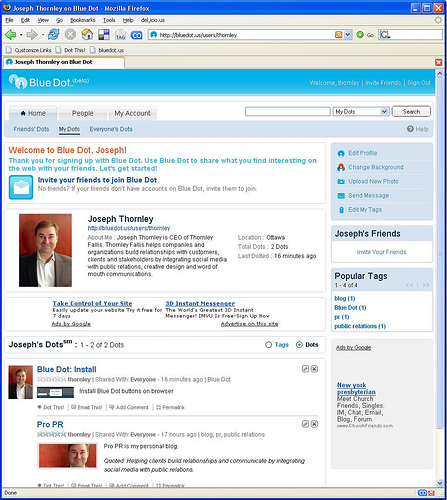 CBC News Online reports that Canada’s Chief of Defence Staff, Rick Hillier, has issued a general order restricting publication of information and images to the Internet by members of Canada’s Armed Forces.
CBC News Online reports that Canada’s Chief of Defence Staff, Rick Hillier, has issued a general order restricting publication of information and images to the Internet by members of Canada’s Armed Forces.
The order notes the risks of posting information or images that might provide insight into the deployment and capabilities of Canadian Forces and that such insight might put those forces at risk. The order requires CF personnel to obtain approval before publishing any military information or images to the Internet.
 The complete text of the order is published on a military discussion forum. I am reproducing it in full below because I believe that it is an important reference document for those interested in the development of blogging policies:
The complete text of the order is published on a military discussion forum. I am reproducing it in full below because I believe that it is an important reference document for those interested in the development of blogging policies:
R 011318Z SEP 06
FM NDHQ CDS OTTAWA
TO CANFORGEN
BT
UNCLAS CANFORGEN 136/06 CDS 050/06
SIC SAK
BILINGUAL MESSAGE/MESSAGE BILINGUE
SUBJ: GUIDANCE ON BLOGS AND OTHER INTERNET COMMUNICATIONS – CF OPERATIONS AND ACTIVITIES
REFS: A.QR AND O 19.36, 19.37, AND 19.375
B.DAOD 2008-1, 2008-4, AND 2008-6
C.NDSP CHAPTER 30
1. RECENTLY THERE HAS BEEN CONSIDERABLE INFORMATION POSTED TO THE INTERNET DESCRIBING THE EXPERIENCES OF CF MEMBERS, PARTICULARLY THOSE DEPLOYED ON OPERATIONS. THESE POSTINGS HAVE INCLUDED COMMENTARIES ON PERSONAL WEBSITES, WEB-LOGS (BLOGS) AND E-MAILS, AND UPLOADED STILL AND VIDEO IMAGERY. THIS MATERIAL HAS BEEN POSTED BY CF MEMBERS DEPLOYED ON OPERATIONS OR IN GARRISON, FAMILIES AND ACQUAINTANCES OF CF MEMBERS, EMBEDDED JOURNALISTS AND OTHER MEDIA, AND THE GENERAL PUBLIC
2. THIS CANFORGEN IS INTENDED TO ENSURE CF MEMBERS, THE CHAIN OF COMMAND, AND SPECIALIST ADVISORS AT ALL LEVELS ARE AWARE OF THE RISKS INHERENT IN MAKING SOME TYPES OF INFORMATION OR IMAGERY AVAILABLE TO THE WIDE AUDIENCE USING THE INTERNET, AND OF THE MEASURES TO BE TAKEN TO PREVENT SUCH RISKS
3. OPERATIONAL SECURITY IS PARAMOUNT. IT IS INCUMBENT UPON ALL CF MEMBERS TO CONSIDER THE POTENTIAL FOR CREATING RISK TO THEMSELVES, THEIR FAMILIES, THEIR PEERS, AND THE MISSION BY PUBLISHING INFORMATION TO THE INTERNET. SUCH INFORMATION OR IMAGERY MAY, EITHER INDIVIDUALLY OR IN CONJUNCTION WITH OTHER INFORMATION, PROVIDE EXPERT ANALYSTS INSIGHTS INTO CF CURRENT OPERATIONS, EQUIPMENT, CAPABILITIES, TACTICS, AND INTENTIONS, OR MAY PROVIDE INFORMATION THAT PUTS PERSONNEL IN SPECIALIST ROLES OR THEIR FAMILIES AT RISK
4. CF MEMBERS ARE TO CONSULT WITH THEIR CHAIN OF COMMAND BEFORE PUBLISHING CF-RELATED INFORMATION AND IMAGERY TO THE INTERNET, REGARDLESS OF HOW INNOCUOUS THE INFORMATION MAY SEEM. THE CHAIN OF COMMAND HAS ACCESS TO EXPERT ADVISORS, SUCH AS PUBLIC AFFAIRS AND INTELLIGENCE STAFFS, WHO WILL ENSURE THAT SUCH PUBLISHED INFORMATION IS NOT ULTIMATELY PREJUDICIAL TO CF OPERATIONS AND PERSONNEL
5. CF MEMBERS ALSO HAVE A RESPONSIBILITY TO ENSURE THAT ANY INFORMATION OR IMAGERY THEY SHARE WITH A THIRD PARTY WHO MAY NOT SHARE CF OPERATIONAL SECURITY CONCERNS IS NOT OF SUCH A NATURE THAT IT COULD CREATE RISKS IF PUBLISHED
6. COLLECTION OF INFORMATION OR IMAGERY BY EMBEDDED JOURNALISTS OR OTHER MEDIA IS SUBJECT TO AGREEMENTS BETWEEN SUCH MEDIA AND THE RESPONSIBLE PUBLIC AFFAIRS STAFF, WHO WILL ENSURE THE APPROPRIATE MANAGEMENT AND RELEASE OF INFORMATION
7. IT IS NOT THE INTENT OF THE CF TO RESTRICT THE INTERNET ACCESS PROVIDED TO CF MEMBERS AS DESCRIBED IN THE REFERENCES. WITHIN GENERALLY WELL-UNDERSTOOD LIMITS, CF MEMBERS ARE ENTITLED TO COMMUNICATE WITH FRIENDS, FAMILY AND COLLEAGUES, AS ARE ALL CANADIAN CITIZENS
8. THE CF CHAIN OF COMMAND, PARTICULARLY IN A THEATRE OF OPERATIONS, HAS THE AUTHORITY TO RESTRICT ACCESS TO THE INTERNET IF IT IS DEEMED ESSENTIAL TO MAINTAINING OPERATIONAL SECURITY
9. LEGAL ADVICE ON THIS CANFORGEN IS AVAILABLE TO THE CHAIN OF COMMAND FROM THE NATIONAL SECURITY DIRECTORATE OF THE CF LEGAL ADVISOR (CFLA)
 The CBC report contains this explanation by a CF spokesman:
The CBC report contains this explanation by a CF spokesman:
“This is something that the military has had to deal with since 2002,” when Canada sent troops to Afghanistan, Lieut. Adam Thomson, an Armed Forces spokesman, told CBC News Online.
He noted the policy has “been a long time in the making.
“We realized that blogs are more influential than we knew,” he said.
At least one observer feels that this policy is heavy handed and sends the signal to Canada’s Forces that “We don’t trust you. If we trusted you, we’d remind you of the security issues, make clear to you that you’ll be disciplined for violations of those security issues, and then let you govern yourself accordingly with limited supervision.”
The Torch points out that the U.S. armed services have taken a different approach. “The key elements are registration of the blog with the chain of command, accountability for any information going up on it, and periodic monitoring by the command for compliance.”
 Happily for me, I have had a very different experience with my bank. I’ve had an 11 year banking relationship with RBC. Even more remarkable, RBC has assigned the same account manager, Bill Helmer, to my account for that entire time. Over the years, he has been a source of advice and support. Bill has suggested ways that the bank could help me with my growth plans (yes, the money is offered when I don’t “need” it, but isn’t the art of management all about staying out of a situation in which you “need” financing.) And from time to time, he has reined me in, counseling that my ambitions might be ahead of my reach or that I needed to focus on fundamentals in order to have a solid foundation for those plans. He has invited me to events such as the economic briefing and networking events. And he has talked positively about my business to many of his own contacts.
Happily for me, I have had a very different experience with my bank. I’ve had an 11 year banking relationship with RBC. Even more remarkable, RBC has assigned the same account manager, Bill Helmer, to my account for that entire time. Over the years, he has been a source of advice and support. Bill has suggested ways that the bank could help me with my growth plans (yes, the money is offered when I don’t “need” it, but isn’t the art of management all about staying out of a situation in which you “need” financing.) And from time to time, he has reined me in, counseling that my ambitions might be ahead of my reach or that I needed to focus on fundamentals in order to have a solid foundation for those plans. He has invited me to events such as the economic briefing and networking events. And he has talked positively about my business to many of his own contacts.


 On October 16, at Third Monday in Ottawa,
On October 16, at Third Monday in Ottawa,  The next night, October 17, Third Tuesday Toronto attendees will spend the evening in discussion with Globe and Mail technology writer Mathew Ingram. “A typical day for Mathew still includes researching and writing copy for tomorrow’s paper, but also populating the Globe’s “
The next night, October 17, Third Tuesday Toronto attendees will spend the evening in discussion with Globe and Mail technology writer Mathew Ingram. “A typical day for Mathew still includes researching and writing copy for tomorrow’s paper, but also populating the Globe’s “ And why should you care where it goes? Mathew will also share his thoughts on why he started blogging, the difference between his personal blog and Geekwatch, the current crop of Web 2.0 technologies and his predictions on the evolution of social media.”
And why should you care where it goes? Mathew will also share his thoughts on why he started blogging, the difference between his personal blog and Geekwatch, the current crop of Web 2.0 technologies and his predictions on the evolution of social media.”
 Hot on the heels of successful CaseCamps in Toronto, Montreal and Vancouver, the first
Hot on the heels of successful CaseCamps in Toronto, Montreal and Vancouver, the first  CaseCamp is the brainchild of
CaseCamp is the brainchild of 


 CBC News Online
CBC News Online  The
The  The CBC report contains this explanation by a CF spokesman:
The CBC report contains this explanation by a CF spokesman: